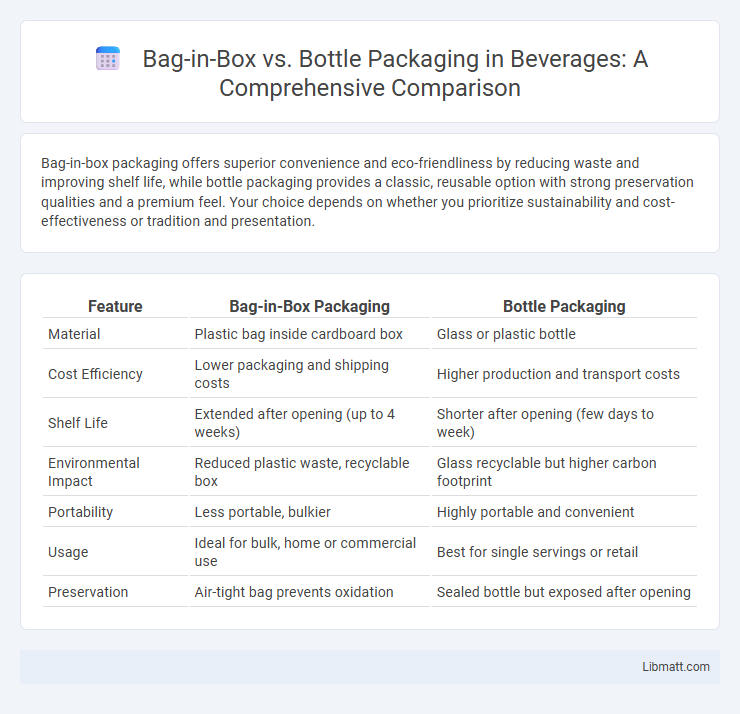Bag-in-box packaging offers superior convenience and eco-friendliness by reducing waste and improving shelf life, while bottle packaging provides a classic, reusable option with strong preservation qualities and a premium feel. Your choice depends on whether you prioritize sustainability and cost-effectiveness or tradition and presentation.
Table of Comparison
| Feature | Bag-in-Box Packaging | Bottle Packaging |
|---|---|---|
| Material | Plastic bag inside cardboard box | Glass or plastic bottle |
| Cost Efficiency | Lower packaging and shipping costs | Higher production and transport costs |
| Shelf Life | Extended after opening (up to 4 weeks) | Shorter after opening (few days to week) |
| Environmental Impact | Reduced plastic waste, recyclable box | Glass recyclable but higher carbon footprint |
| Portability | Less portable, bulkier | Highly portable and convenient |
| Usage | Ideal for bulk, home or commercial use | Best for single servings or retail |
| Preservation | Air-tight bag prevents oxidation | Sealed bottle but exposed after opening |
Introduction to Bag-in-Box and Bottle Packaging
Bag-in-box packaging consists of a flexible bag housed within a rigid box, designed primarily for liquids like wine, juice, and syrup, offering extended freshness and ease of storage. Bottle packaging, typically made of glass or plastic, is a traditional container favored for preserving the quality and presentation of beverages. Your choice between bag-in-box and bottle packaging depends on factors such as product shelf life, convenience, environmental impact, and brand positioning.
Material Composition and Sustainability
Bag-in-box packaging consists of a plastic bladder enclosed in a cardboard box, significantly reducing plastic usage compared to traditional glass bottles. Glass bottles require higher energy for production and transport due to their weight and non-collapsible nature, resulting in a larger carbon footprint. The bag-in-box system offers enhanced sustainability by using recyclable cardboard and minimizing material waste, making it a more eco-friendly option in packaging.
Storage Efficiency and Shelf Life
Bag-in-box packaging offers superior storage efficiency by utilizing flexible, collapsible bags that reduce wasted space compared to rigid bottles. This packaging type extends shelf life by minimizing oxygen exposure, preserving product freshness for weeks after opening. Bottles, while providing better individual portion control, typically have longer initial shelf life but consume more storage space and can lead to faster oxidation once opened.
Cost Comparison: Bag-in-Box vs Bottle
Bag-in-box packaging significantly reduces costs compared to traditional bottles by lowering material expenses, shipping weight, and storage space requirements. Production and transportation efficiencies make bag-in-box a more economical choice for bulk or extended use, while glass bottles often incur higher costs due to fragile packaging and heavier shipping fees. Your decision between bag-in-box and bottle packaging depends on balancing upfront investment with long-term savings and product preservation needs.
Environmental Impact and Recycling
Bag-in-box packaging significantly reduces environmental impact by using less plastic and producing lower carbon emissions during manufacturing and transportation compared to bottles. Its lightweight design minimizes waste and energy consumption, making it easier and more efficient to recycle. You can contribute to sustainability efforts by choosing bag-in-box options that support reduced landfill waste and promote circular economy practices.
Transportation and Logistics Advantages
Bag-in-box packaging offers significant transportation and logistics advantages due to its lightweight design and efficient space utilization, allowing more product to be shipped in fewer shipments compared to traditional bottles. The flexible bags reduce overall package weight and volume, decreasing transportation costs and carbon emissions. Furthermore, the stackable nature of bag-in-box containers optimizes palletizing and storage efficiency across the supply chain.
Consumer Convenience and Usability
Bag-in-box packaging offers enhanced consumer convenience with its lightweight design and easy-to-pour spout, reducing spills and mess compared to traditional bottles. This packaging is ideal for frequent use, as it keeps liquids fresher longer through minimal air exposure, extending product usability after opening. Your daily routine benefits from the bag-in-box's portability and space-saving features, making it a practical choice over rigid bottle packaging.
Product Preservation and Quality Control
Bag-in-box packaging offers superior product preservation by minimizing oxygen exposure, significantly reducing oxidation and spoilage compared to traditional bottles. The airtight, flexible bag collapses as the product is dispensed, maintaining freshness and consistent quality over extended periods. Your choice of bag-in-box ensures enhanced quality control, especially for beverages or perishable liquids, by preventing contamination and preserving flavor integrity.
Market Trends and Industry Adoption
Bag-in-box packaging has experienced rapid growth in the beverage industry due to its cost-effectiveness, sustainability, and extended product freshness, capturing significant market share from traditional bottles. Leading wine and juice brands increasingly adopt bag-in-box solutions to meet consumer demand for convenience and eco-friendly options. Your choice between bag-in-box and bottle packaging should consider evolving market trends favoring lightweight, recyclable materials that reduce carbon footprint and enhance supply chain efficiency.
Choosing the Right Packaging for Your Product
Bag-in-box packaging offers extended shelf life and reduced environmental impact compared to traditional bottles, making it ideal for products requiring freshness and convenience. Bottles, especially glass, provide a premium presentation and are preferred for products needing airtight sealing and aesthetic appeal. Your choice depends on product type, storage conditions, and consumer expectations, balancing cost efficiency with brand image.
Bag-in-box vs bottle packaging Infographic

 libmatt.com
libmatt.com